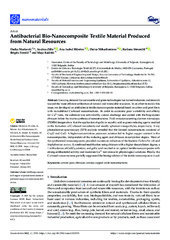Приказ основних података о документу
Antibacterial Bio-Nanocomposite Textile Material Produced from Natural Resources
| dc.creator | Marković, Darka | |
| dc.creator | Zille, Andrea | |
| dc.creator | Ribeiro, Ana Isabel | |
| dc.creator | Mikučioniene, Daiva | |
| dc.creator | Simončič, Barbara | |
| dc.creator | Tomšič, Brigita | |
| dc.creator | Radetić, Maja | |
| dc.date.accessioned | 2023-01-11T13:31:16Z | |
| dc.date.available | 2023-01-11T13:31:16Z | |
| dc.date.issued | 2022 | |
| dc.identifier.issn | 2079-4991 | |
| dc.identifier.uri | http://TechnoRep.tmf.bg.ac.rs/handle/123456789/5305 | |
| dc.description.abstract | Growing demand for sustainable and green technologies has turned industries and research toward the more efficient utilization of natural and renewable resources. In an effort to tackle this issue, we developed an antibacterial textile nanocomposite material based on cotton and peat fibers with immobilized Cu-based nanostructures. In order to overcome poor wettability and affinity for Cu2+-ions, the substrate was activated by corona discharge and coated with the biopolymer chitosan before the in situ synthesis of nanostructures. Field emission scanning electron microscopy (FESEM) images show that the application of gallic or ascorbic acid as green reducing agents resulted in the formation of Cu-based nanosheets and mostly spherical nanoparticles, respectively. X-ray photoelectron spectroscopy (XPS) analysis revealed that the formed nanostructures consisted of Cu2O and CuO. A higher-concentration precursor solution led to higher copper content in the nanocomposites, independent of the reducing agent and chitosan deacetylation degree. Most of the synthesized nanocomposites provided maximum reduction of the bacteria Escherichia coli and Staphylococcus aureus. A combined modification using chitosan with a higher deacetylation degree, a 1 mM solution of CuSO4 solution, and gallic acid resulted in an optimal textile nanocomposite with strong antibacterial activity and moderate Cu2+-ion release in physiological solutions. Finally, the Cu-based nanostructures partially suppressed the biodegradation of the textile nanocomposite in soil. | sr |
| dc.language.iso | en | sr |
| dc.publisher | MDPI | sr |
| dc.relation | Open access funding was provided by COST Action “European Network to connect research and innovation efforts on advanced Smart Textiles” (CONTEXT, Ref. CA17107, https: //www.context-cost.eu (accessed on 1 July 2020)). | sr |
| dc.relation | info:eu-repo/grantAgreement/MESTD/inst-2020/200135/RS// | sr |
| dc.relation | info:eu-repo/grantAgreement/MESTD/inst-2020/200287/RS// | sr |
| dc.relation | The Slovenian Research Agency (Program P2-0213 Textiles and Ecology). | sr |
| dc.rights | openAccess | sr |
| dc.rights.uri | https://creativecommons.org/licenses/by/4.0/ | |
| dc.source | Nanomaterials | sr |
| dc.subject | chitosan | sr |
| dc.subject | copper oxide nanostructures | sr |
| dc.subject | corona | sr |
| dc.subject | cotton | sr |
| dc.subject | peat | sr |
| dc.title | Antibacterial Bio-Nanocomposite Textile Material Produced from Natural Resources | sr |
| dc.type | article | sr |
| dc.rights.license | BY | sr |
| dc.citation.issue | 15 | |
| dc.citation.rank | M21~ | |
| dc.citation.spage | 2539 | |
| dc.citation.volume | 12 | |
| dc.identifier.doi | 10.3390/nano12152539 | |
| dc.identifier.fulltext | http://TechnoRep.tmf.bg.ac.rs/bitstream/id/13827/Antibacterial_Bio-Nanocomposite_pub_2022.pdf | |
| dc.identifier.scopus | 2-s2.0-85136995084 | |
| dc.identifier.wos | 00083984390000 | |
| dc.type.version | publishedVersion | sr |

